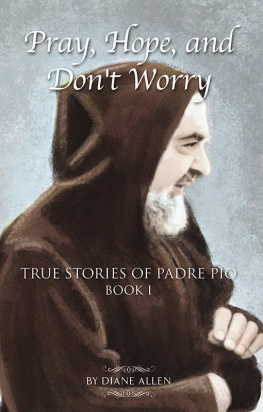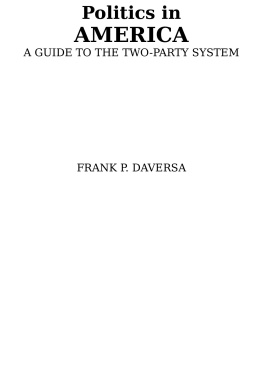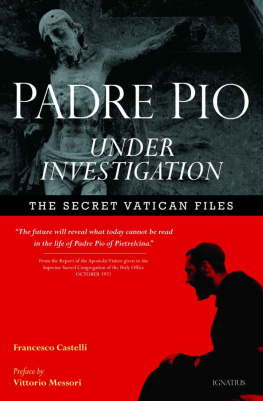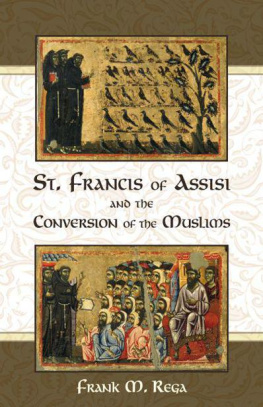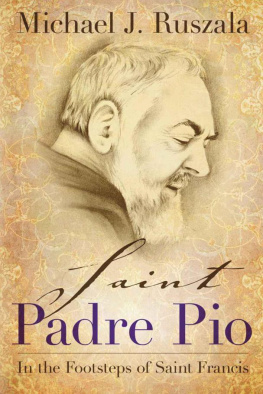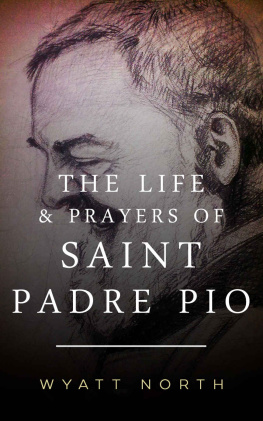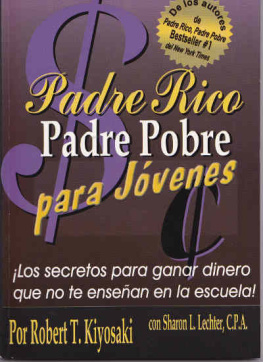Frank Rega - Padre Pio and America
Here you can read online Frank Rega - Padre Pio and America full text of the book (entire story) in english for free. Download pdf and epub, get meaning, cover and reviews about this ebook. year: 2013, publisher: TAN Books, genre: Non-fiction. Description of the work, (preface) as well as reviews are available. Best literature library LitArk.com created for fans of good reading and offers a wide selection of genres:
Romance novel
Science fiction
Adventure
Detective
Science
History
Home and family
Prose
Art
Politics
Computer
Non-fiction
Religion
Business
Children
Humor
Choose a favorite category and find really read worthwhile books. Enjoy immersion in the world of imagination, feel the emotions of the characters or learn something new for yourself, make an fascinating discovery.

- Book:Padre Pio and America
- Author:
- Publisher:TAN Books
- Genre:
- Year:2013
- Rating:3 / 5
- Favourites:Add to favourites
- Your mark:
- 60
- 1
- 2
- 3
- 4
- 5
Padre Pio and America: summary, description and annotation
We offer to read an annotation, description, summary or preface (depends on what the author of the book "Padre Pio and America" wrote himself). If you haven't found the necessary information about the book — write in the comments, we will try to find it.
Padre Pio and America — read online for free the complete book (whole text) full work
Below is the text of the book, divided by pages. System saving the place of the last page read, allows you to conveniently read the book "Padre Pio and America" online for free, without having to search again every time where you left off. Put a bookmark, and you can go to the page where you finished reading at any time.
Font size:
Interval:
Bookmark:
He shall feed his flock like a shephered: he shall gather together the lambs with his arm, and shall take them up in his bosom, and he himself shall carry them that are with young.
Isaias 40:11

Padre Pio distributing medals to American GIs.

Copyright 2004, 2005 by Frank M. Rega
First edition published in 2004 by Aventine Press, Chula Vista, CA, under the title The Holy Man on the Mountain.
ISBN 978-0-89555-820-6
Cover photo of Padre Pio and many other photos courtesy of Our Lady of Grace Capuchin Friary, San Giovanni Rotondo, Italy.
All rights reserved. Brief selections of text from this book may be quoted or copied for non-profit use without permission, and brief selections may be quoted by a reviewer in a review without permission. Otherwise, no part of this book may be reproduced or transmitted in any form or by any means, electronic or mechanical, including photocopying, recording, or by any information storage or retrieval system, without permission in writing from the Publisher.
Printed and bound in the United States of America.
TAN Books
An Imprint of Saint Benedict Press, LLC
Charlotte, North Carolina
2012
Dedication
This book is dedicated to the American GIs who met
Padre Pio during World War II,
and to their families and friends, whose co-operation,
sharing and enthusiasm
have made this book possible.
Table of Contents
Although many people have co-operated and helped with this book, it would never have gotten off the ground were it not for two Padre Pio devotees, Jeanette and Joan Salerno of Brooklyn. It was the Salerno sisters, along with Buck Fleming from Colorado (CEO of Admin Force), who first suggested that I pursue my interest in writing, after my early retirement from the computer field. When I emailed Jeanette and Joan, asking them what they thought of a book about Padre Pio and America, Joan replied, As soon as I read your idea, it was, WHAM!
Thanks go to Alice Coble for allowing me to include her husband Bobs manuscript in the book, and to the Salernos for introducing me to Alice. Special thanks to the late Charles Mandina for providing the contact information for a critically important core group of American GIs who had met Padre Pio during World War II. In addition, Julie Fitts-Ritter, of the Padre Pio Foundation of America, provided the names of a number of persons who were interviewed for this book, including Mrs. Rita Peluso. Julie also arranged to have the chapter on Padre Pios father, Grazio Forgione, published in the Foundations newsletter. The efforts of Ray Waychunas, who gives talks about Padre Pio in the Pennsylvania area, are especially appreciated. Ray read and commented on every chapter during the course of the writing of the book. Also, I want to recognize the kind assistance of Maria Calandra of the National Centre for Padre Pio. I am grateful to Mario Avignone for granting permission to reproduce parts of his unpublished manuscript, which describes his encounters with Padre Pio during the war years. Also, thanks to C. Bernard Ruffin for sharing documents he received from the late Fr. John Schug, related to the Flying Monk episodes.
There are so many World War II veterans and their spouses who eagerly shared their stories and photos, that I dont want to single out any in particular, since it would be unfair to the others. Their names appear together in the oral history section of the references, as well as in the text itself. I would like to thank them for giving me a sense of the great affection they felt for Padre Pio, and of how important it was for them to be able to share their memories of him. They made me realize that it was both a privilege and a responsibility to be able to gather their testimonies for this book.
At the Friary in San Giovanni Rotondo, I would like to thank Charles Abercrombie, Antonio Siena and Julie Cifaldi for their help in resolving many issues. I am also grateful to the Capuchins of Our Lady of Grace Friary for permission to quote extensively from their many books and periodicals, as well as to use a number of their photos. Scripture citations that are not imbedded in quoted material are taken from the New American Bible. This version is available at the web site of the United States Conference of Catholic Bishops,
I came to know of Padre Pio only gradually, discovering him just a few years after his death in 1968. Perhaps a friend had told me about him, or I might have heard of him through my interest in St. Francis of Assisi. As a Capuchin friar, Padre Pio was himself a Franciscan. I cannot recall any particular book or article I read about him; instead, it seems that this friar from Southern Italy, well, just crept up on me.
As I learned more about him, and saw the photos of his friary, of Our Lady of Grace Church and of the adjacent hospital he built, called the House for the Relief of Suffering, an attraction for this distant realm began to grow. Soon the very words themselves, such as Gargano mountain and the nearby shrine to St. Michael, Monte SantAngelo, and the Italian name for his hospital, Casa Sollievo della Sofferenza, began to take on a fairy-tale quality. Even the names of the towns associated with him, San Giovanni Rotondo and Pietrelcina, conjured up some magical sunshiny world. Included in this world was Foggia, the provincial capital which played an important part in Padre Pios life and turns up in so many stories about the American soldiers who visited him during the War. Foggia was the closest rail terminal to the Friary, where the trains from Rome and Naples dropped off their pilgrims and visitors, and to me it seemed to be the imaginary gateway to this mystical land.
But most of all, it was the sense of the spiritual and of the peaceful awareness of God that one associates with Padre Pio and the places where he lived that continued to attract me. Finally, in the early 1990s, with the approach of the 25th anniversary of his death, I began to read about a spate of Padre Pio Pilgrimages leaving from the United States for San Giovanni Rotondo, Rome, Assisi and other Italian shrines. The lure could no longer be resisted. Although I had never been out of the U.S.A. and was about 50 years old, I obtained my passport, signed up for an anniversary trip and began to learn the Italian language during Monday evening adult education classes. Even though my heritage is from the Old Country via my grandparents, I had never learned the language. My parents, who were born in America, only spoke Italian when they didnt want us children to know what they were talking about!
On the 1993 pilgrimage that I had ultimately chosen, our groups anticipation grew as the bus made its way into Southern Italy. As we climbed the slopes of the Gargano, my eyes were taking in everything, hoping to catch that first glimpse of a building or landscape that I could recognize from the pictures I had seen. We reached the outskirts of San Giovanni Rotondo while it was still daylight, and then suddenly I spotted it, jutting out from the side of the mountain, extending along the hillside, solid looking, like a golden granite monument. It was Padre Pios great legacy, his majestic hospital, the House for the Relief of Suffering. I had seen so many photos of it in books, and now it seemed that one of these photographs had just come to life, moving in three dimensions as the bus slowly rolled along. Soon the Friary and its churches, the original and the newer one, came into view. I had entered another world, not just geographically, but spiritually and with my whole being.
Font size:
Interval:
Bookmark:
Similar books «Padre Pio and America»
Look at similar books to Padre Pio and America. We have selected literature similar in name and meaning in the hope of providing readers with more options to find new, interesting, not yet read works.
Discussion, reviews of the book Padre Pio and America and just readers' own opinions. Leave your comments, write what you think about the work, its meaning or the main characters. Specify what exactly you liked and what you didn't like, and why you think so.


